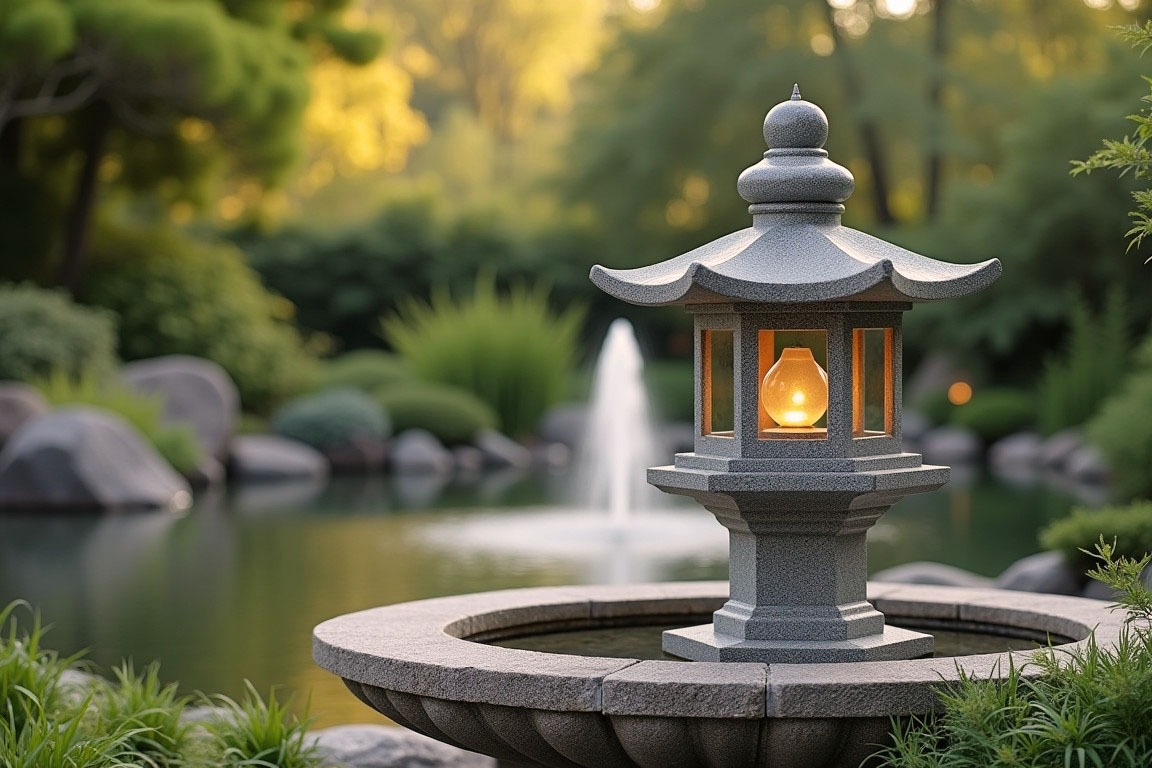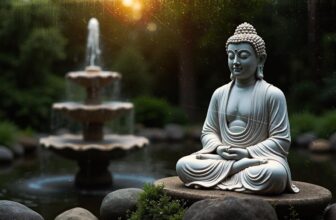
What Does the Pagoda Lantern Sculpture Represent
In a tranquil garden tucked behind a Zen temple in Kyoto, bathed in the amber hues of the late afternoon sun, stands a modest yet evocative stone structure. It is not a towering Buddha nor a grand torii gate, but a pagoda lantern sculpture, worn gently by centuries of rain, wind, and reverent gazes. To the untrained eye, it may seem like just a decorative feature, charming, yes, but ordinary. However, to those who understand its essence, the pagoda lantern is far more than stone and form. It is a symbol of light, spiritual grounding, harmony, and good fortune.
This story unfolds not only across East Asia’s gardens and temples, but also in modern homes and landscapes across the world. The pagoda lantern sculpture, with its elegant lines and rooted symbolism, has journeyed across time and continents to become a profound artistic and spiritual artifact. In this article, we explore what the pagoda lantern sculpture represents, what it symbolizes in art, its spiritual and cultural meanings, and why it is increasingly revered as a garden sculpture that invites good fortune, mindfulness, and beauty.
The Birth of the Pagoda Lantern
The pagoda lantern, or tōrō (灯籠) in Japanese, is a traditional type of lantern originally introduced to Japan from China and India via Buddhism in the 6th century. The lantern itself was not merely a utilitarian object to hold a flame, but a sacred vessel of light, used to illuminate the paths of temple grounds, guide spirits, and symbolize enlightenment.
In its earliest form, the pagoda lantern had practical purposes. Early Buddhist monks used these lanterns during ceremonies and as part of temple architecture. But as their use spread, so too did their meaning. Over centuries, artisans carved the lanterns with ornate details, added pagoda-style roofs to honor Buddhist architecture, and placed them strategically in gardens, shrines, and spiritual retreats.
The transformation from a light source to a sculpture of deep symbolic meaning was gradual but profound. As Japanese aesthetics embraced principles like wabi-sabi (the beauty of imperfection and impermanence) and shizen (naturalness), the pagoda lantern became a bridge between art, nature, and the sacred.
At its core, the pagoda lantern sculpture represents illumination, not just literal light, but spiritual awakening and inner clarity.
In Buddhism, light is synonymous with wisdom. A lantern does not simply brighten a path; it dispels ignorance, a central tenet in Buddhist teachings. The sculpture, often made from stone, is meant to last across generations, acting as a silent sentinel of enlightenment.
Beyond the religious lens, the pagoda lantern has come to embody several layers of meaning:
Harmony: Its multi-tiered structure mirrors the tiered heavens and represents balance between earth, humanity, and the divine.
Guidance: It serves as a spiritual compass, traditionally placed to mark sacred or meditative spaces.
Peace: The gentle, grounded presence of the sculpture evokes stillness, calm, and reflection.
Timelessness: Often made of stone, the lantern withstands the erosion of time, reminding viewers of permanence amidst impermanence.
The Pagoda Lantern in Art: A Symbol of Simplicity and Sublimity
In Asian art and sculpture, the pagoda lantern is more than a subject; it is an anchor. It occupies a special role in Japanese garden design, ink paintings, woodblock prints, and even contemporary sculpture.
In Japanese Garden Design
The pagoda lantern is a cornerstone of Zen garden aesthetics. Unlike Western art, which often centers on vivid realism or narrative, Japanese art is minimal, suggestive, and infused with metaphysical intention. The lantern, when placed thoughtfully near water, a path, or under a tree, becomes a visual and spiritual punctuation mark.
Its stone mass contrasts beautifully with the soft texture of moss, the trickle of a stream, or the delicate fall of cherry blossoms. As the seasons shift, the lantern takes on new visual dimensions, dusted with snow in winter, wrapped in vines during summer, or silhouetted by maple leaves in autumn.
Each placement is intentional and symbolic, often aligned with the cardinal directions, water sources, or near a meditation spot.
In Japanese and Chinese Painting
In ink wash paintings, pagoda lanterns are frequently depicted among temples, gardens, and mountains, representing not only place but mood. Their presence suggests a human touch within nature, a reminder that harmony between humanity and the natural world is not only possible but beautiful.
In Modern Sculpture and Art Installations
Today, artists around the world reinterpret the pagoda lantern in various media, from abstract metal sculptures to ceramic garden lights. Despite stylistic innovations, the core meaning remains: light, peace, contemplation, and guidance.
The Spiritual Meaning of the Pagoda Lantern Sculpture
Each component of the pagoda lantern is rich in symbolism. Traditionally, the lantern consists of five parts, corresponding to the five elements of Buddhist cosmology:
Earth (Chi) – The base, grounding the lantern and connecting it to the earth.
Water (Sui) – The next tier, symbolizing adaptability and flow.
Fire (Ka) – The hollow light chamber, representing illumination and transformation.
Wind (Fu) – The upper section, denoting breath, movement, and spirit.
Void (Ku) – The pinnacle, pointing to the sky and the unknowable realm of the divine.
These elements form a metaphor for the journey of human consciousness, from grounded reality to transcendent insight. When meditating near a pagoda lantern sculpture, many practitioners reflect on this upward journey, letting the structure guide their spiritual ascent.
Is the Pagoda Lantern Sculpture Good for Gardens?
Absolutely, both aesthetically and spiritually.
Aesthetic Value
From a design perspective, pagoda lanterns are incredibly versatile. Whether your garden is minimalist, lush, dry (karesansui), or floral, the lantern integrates seamlessly. It provides structure without dominance, blending with the environment rather than overpowering it.
You’ll often find several styles:
Kasuga-dōrō (bronze or stone lanterns from the Nara period)
Yukimi-dōrō (“snow-viewing” lanterns with wide roofs)
Tachi-gata (tall pedestal lanterns)
Ikekomi-dōrō (partially buried lanterns used near water features)
Each has unique proportions suited to specific landscape features, but all share the same core symbolism.
Psychological and Emotional Value
Adding a pagoda lantern sculpture to your garden creates a sanctuary-like effect. It promotes mindful observation, a key element in Japanese gardens. As your eye moves to the lantern, you are subtly invited to pause, breathe, and reflect.
In modern life, where natural and sacred spaces are increasingly rare, a garden pagoda lantern can serve as a portal to peace and personal ritual.
Does the Pagoda Lantern Sculpture Bring Good Luck?
In both Feng Shui and Japanese folklore, the pagoda lantern is considered auspicious.
Feng Shui and Energy Flow
Pagodas in general are believed to store positive chi and protect against negative energies. A pagoda lantern sculpture, especially when placed near a water feature or entrance, is thought to:
Attract good luck
Protect the household from misfortune
Encourage the flow of creativity and wisdom
For best results, it’s advised to place the lantern in the northeast (for wisdom) or southeast (for wealth and growth) areas of your property, according to the Bagua map of Feng Shui.
Japanese Beliefs and Symbolism
In Japanese tradition, the presence of a pagoda lantern in the garden signifies blessings, protection, and peaceful energy. Monks and gardeners alike believe that it attracts benevolent spirits, and in the Edo period, samurai often commissioned lanterns to be built in their personal gardens to bring spiritual clarity and good fortune.
Modern Uses: A Spiritual Sculpture for Every Space
As the world grows more urban and chaotic, many people are turning toward mindful, meaningful decor that goes beyond aesthetics. The pagoda lantern sculpture has found a place not just in traditional gardens, but in:
Meditation rooms
Yoga studios
Spa resorts
Zen-inspired patios
Interior design pieces
Whether lit with a candle, solar light, or left unlit, the sculpture becomes a reminder of inner light and calm.
Choosing the Right Pagoda Lantern Sculpture for Your Space
When selecting a pagoda lantern, consider the following:
Material: Stone is traditional and most enduring. Resin or ceramic is lighter and often more affordable.
Size: Tall pedestal lanterns suit larger spaces; shorter lanterns are ideal for intimate corners or bonsai gardens.
Style: Opt for traditional Japanese designs for authenticity, or contemporary interpretations for modern gardens.
Placement: Near water, paths, or under trees, areas where the lantern can be both seen and “experienced.”
Purpose: Is it purely decorative, or will you light it? Solar-powered lights are eco-friendly and practical.
The Enduring Light of the Pagoda Lantern
The pagoda lantern sculpture is a quiet guardian of beauty, spirit, and balance. Rooted in ancient traditions yet ever relevant, it continues to illuminate the paths of monks, artists, gardeners, and everyday seekers of peace.
Whether placed in a tranquil garden, a modern backyard, or a meditation room, the pagoda lantern brings more than visual charm, it brings meaning. It speaks of light in darkness, of balance amidst chaos, and of a life lived with intention and reverence.
In a world that often feels fast and fragmented, the still presence of a pagoda lantern sculpture reminds us to pause, to reflect, and to return to the light within.




